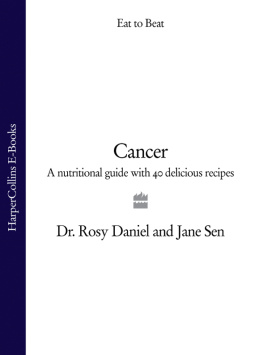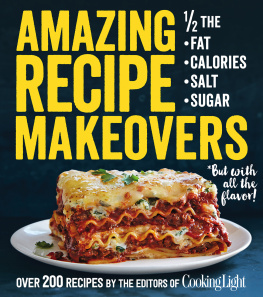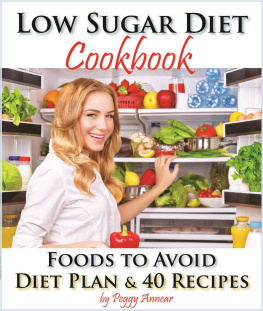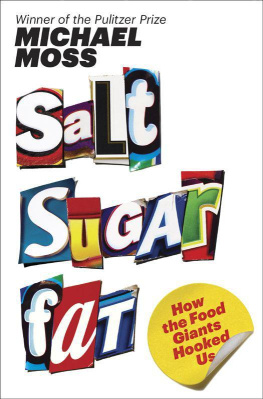Table of Contents
List of tables
- Tables in Chapter one
- Tables in Chapter six
List of illustrations
- Figures in Chapter two
- Figures in Chapter three
- Figures in Chapter four
- Figures in Chapter five
- Figures in Chapter six
- Figures in Chapter eight
- Figures in Chapter nine
- Figures in Chapter ten
- Figures in Chapter eleven
- Figures in Chapter twelve
Landmarks
Table of Contents
Salt, Fat and Sugar Reduction
Sensory Approaches for Nutritional Reformulation of Foods and Beverages
Maurice G. OSullivan

Copyright
Woodhead Publishing is an imprint of Elsevier
The Officers Mess Business Centre, Royston Road, Duxford, CB22 4QH, United Kingdom
50 Hampshire Street, 5th Floor, Cambridge, MA 02139, United States
The Boulevard, Langford Lane, Kidlington, OX5 1GB, United Kingdom
Copyright 2020 Elsevier Inc. All rights reserved.
No part of this publication may be reproduced or transmitted in any form or by any means, electronic or mechanical, including photocopying, recording, or any information storage and retrieval system, without permission in writing from the publisher. Details on how to seek permission, further information about the Publishers permissions policies and our arrangements with organizations such as the Copyright Clearance Center and the Copyright Licensing Agency, can be found at our website: www.elsevier.com/permissions.
This book and the individual contributions contained in it are protected under copyright by the Publisher (other than as may be noted herein).
Notices
Knowledge and best practice in this field are constantly changing. As new research and experience broaden our understanding, changes in research methods, professional practices, or medical treatment may become necessary.
Practitioners and researchers must always rely on their own experience and knowledge in evaluating and using any information, methods, compounds, or experiments described herein. In using such information or methods they should be mindful of their own safety and the safety of others, including parties for whom they have a professional responsibility.
To the fullest extent of the law, neither the Publisher nor the authors, contributors, or editors, assume any liability for any injury and/or damage to persons or property as a matter of products liability, negligence or otherwise, or from any use or operation of any methods, products, instructions, or ideas contained in the material herein.
British Library Cataloguing-in-Publication Data
A catalogue record for this book is available from the British Library
Library of Congress Cataloging-in-Publication Data
A catalog record for this book is available from the Library of Congress
ISBN: 978-0-12-819741-7 (print)
ISBN: 978-0-12-822612-4 (online)
For information on all Woodhead Publishing publications visit our website at https://www.elsevier.com/books-and-journals
Publisher: Charlotte Cockle
Acquisitions Editor: Megan R. Ball
Editorial Project Manager: Sara Valentino
Production Project Manager: Sojan P. Pazhayattil
Cover Designer: Victoria Pearson
Typeset by MPS Limited, Chennai, India

Preface
Nutritional optimization of foods and beverages has always been a part of product innovation. However, in my long career as a food scientist, both in industry and as an academic, I cannot remember a period when this innovation has reached such intensity. A trip to the supermarket reveals a product range for celiacs far more diverse than at any other time. Processed meats have brand leading reduced salt and fat variants with some developed cured meats containing alternate or even organic nitrite sources. The number of vegans in Ireland and the United Kingdom increased fourfold between 2014 and 2019. Six percent of consumers in the United States claim to be vegans, a 600% increase in 3 years. Plant-based lifestyles have got the attention of producers with reduced meat or meat-free variants of main-stream products reaching the marketplace. Bioactive containing dairy and beverage products are widely available to assist in maintaining a healthy microbiome. In the spring of 2018, Ireland and the United Kingdom introduced a coordinated sugar tax on soft drinks. For producers in Ireland, this resulted in products containing between 5 and 8 g sugar/100 mL being levied at 20c/L, while those over 8 g/100 mL are levied at 30c/L. This resulted in dramatic increases in reformulation projects by the beverage sector.
This inertia to reformulate is being driven by consumers who are demanding products to provide their nutritional desires for healthier lifestyles and by government incentives devised to combat the civilization diseases obesity, diabetes, cardiovascular disease, and even cancer. This, in turn, has encouraged the industry to reformulate, through commercial necessity, and if they are to succeed, they must maintain safety, shelf life, and commercial viability. Salt, fat, and sugar are the main targets for reformulation in industry by reduction or replacement because of their contribution to the abovementioned civilization diseases, although this is easier said than done. Salt and sugar are tastants, preservatives, flavor enhancers, as well as functional ingredients; salt assists in water binding in meat, whereas sugar in baking is essential for cake volume. Fat is a functional ingredient and plays a vital sensory role in baked products, and for all fat-containing foods it contributes to flavor, mouthfeel, taste, aroma, appearance, structure, texture, and satiety. Modifying recipes thus has complex effects and interactions. However, food scientists have successfully risen to the challenge as evidenced by the plethora of reformulated products available in our supermarkets across the product spectrum. This book outlines the background, issues, and challenges required in the reformulation of foods and beverages. This is presented with an emphasis on sensory- and consumer-driven strategies as ultimately the consumer demands healthier products that still taste great and have high acceptance and appeal.
Acknowledgment
Thanks to Mary for editorial guidance and feedback.
Chapter one
Understanding the requirement to reformulate; science, health, consumer demand, regulation, and capability
Abstract
This chapter will explore a brief review of the major negative-targeted ingredients, salt, sugar and fat, and their current scientific basis for linking them to the civilization diseases. Consumer awareness of the negative nutritional impact of these ingredients will be discussed through feedback from some recent survey work as well as government initiatives such as pricing and sequential ingredient reduction programs. Sugar, fat, and salt taxes will also be discussed as well as all the, abovementioned, factors as drivers for nutritional optimization through reformulation in the food and beverage industries. Finally a brief summary of reformulation capability is presented where essential steps must be reviewed before any project is implemented. These include regulatory requirements, safety, pricing, technological capability and product stability monitoring.








